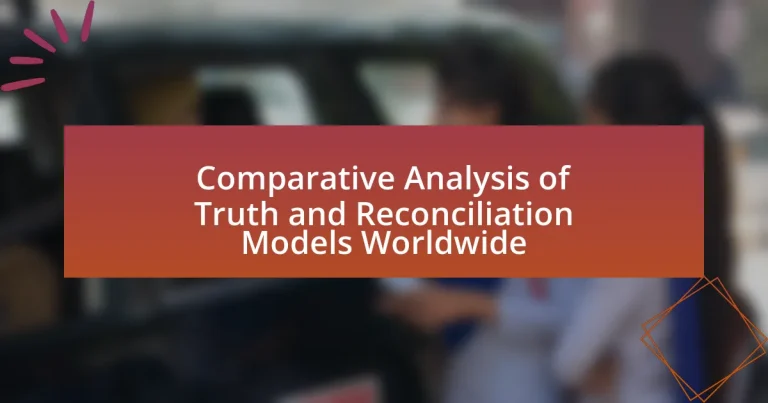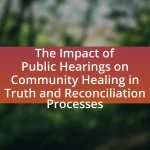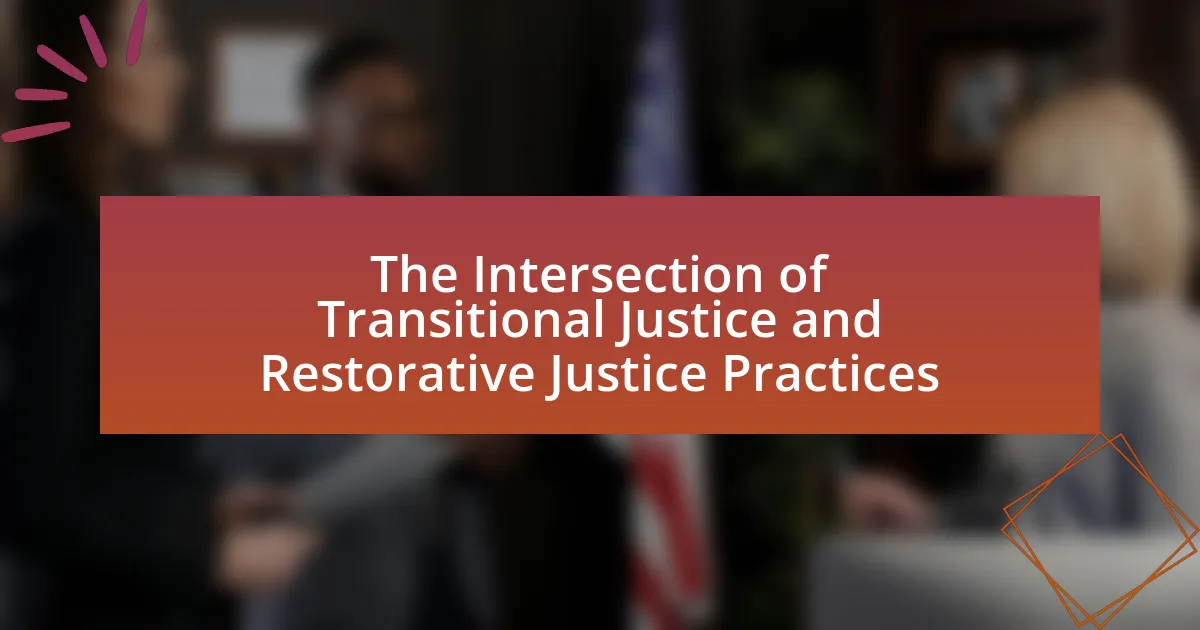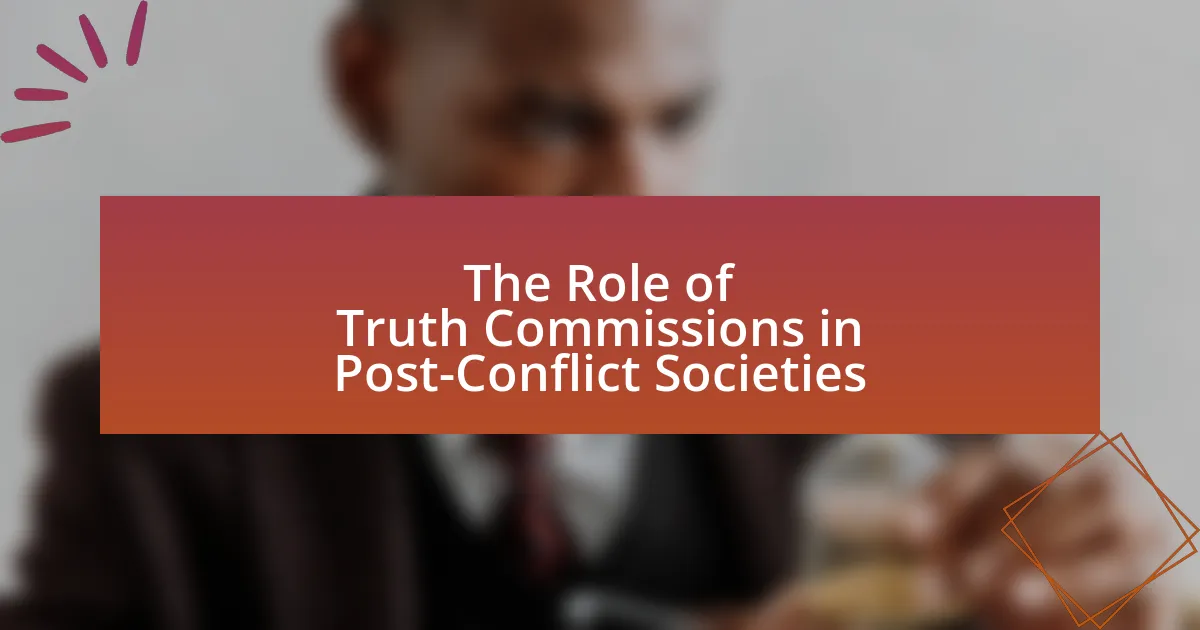Truth and Reconciliation Models are frameworks aimed at addressing past human rights violations and fostering healing in societies transitioning from conflict or authoritarian rule. This article provides a comparative analysis of these models worldwide, highlighting their key components, such as truth-seeking mechanisms, reparations, and community engagement. It examines the influence of cultural contexts on the effectiveness of these models, discusses notable examples like South Africa’s Truth and Reconciliation Commission, and addresses the challenges they face, including political dynamics and societal attitudes. Additionally, the article explores alternative approaches and best practices for improving these models to enhance their impact on healing and justice in post-conflict societies.
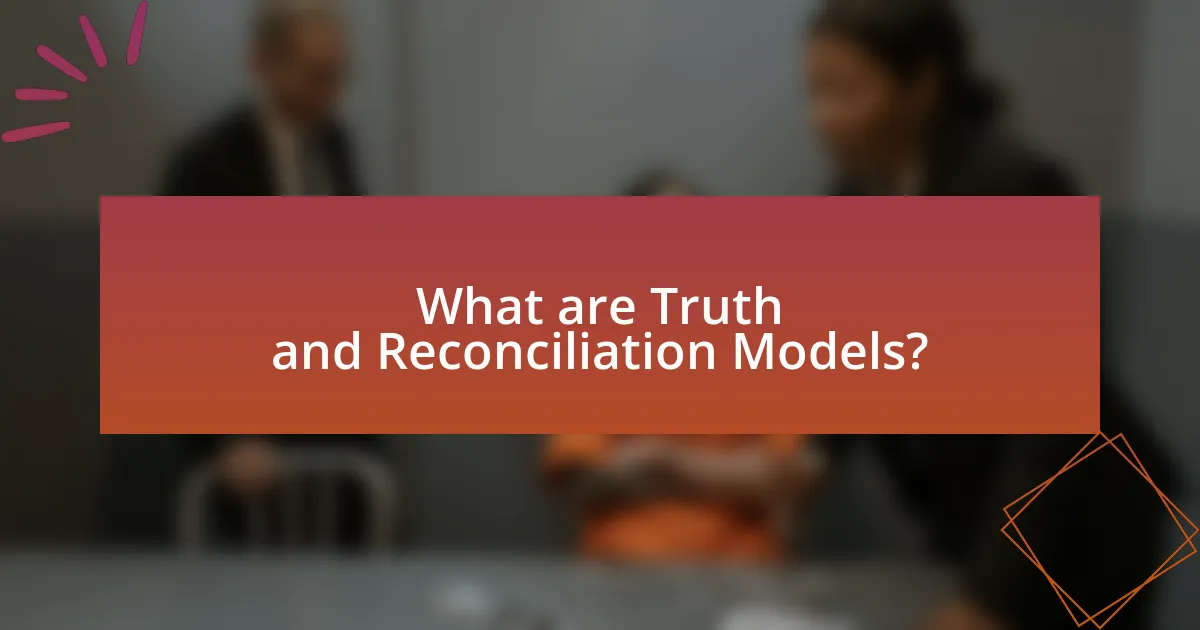
What are Truth and Reconciliation Models?
Truth and Reconciliation Models are frameworks designed to address past human rights violations and promote healing in societies transitioning from conflict or authoritarian rule. These models typically involve processes that facilitate dialogue, acknowledgment of wrongdoing, and reparations for victims, aiming to foster national unity and prevent future violence. For instance, South Africa’s Truth and Reconciliation Commission, established in 1995, is a prominent example, which documented human rights abuses during apartheid and offered amnesty to perpetrators who fully disclosed their actions. This model has influenced similar initiatives in countries like Rwanda and Canada, demonstrating its effectiveness in reconciling divided societies.
How do Truth and Reconciliation Models function globally?
Truth and Reconciliation Models function globally by facilitating dialogue, acknowledging past injustices, and promoting healing in post-conflict societies. These models, such as South Africa’s Truth and Reconciliation Commission, aim to uncover the truth about human rights violations, provide a platform for victims to share their experiences, and encourage accountability among perpetrators. For instance, the South African model led to the documentation of over 21,000 human rights violations and fostered national healing through public testimonies. Globally, similar models have been implemented in countries like Rwanda and Canada, where they have contributed to societal reconciliation and the establishment of restorative justice practices. These models demonstrate the effectiveness of structured processes in addressing historical grievances and building a foundation for sustainable peace.
What are the key components of these models?
The key components of truth and reconciliation models include truth-seeking mechanisms, reparations, institutional reforms, and community engagement. Truth-seeking mechanisms, such as truth commissions, are established to uncover and document past human rights violations, providing a historical record. Reparations involve compensating victims for their suffering, which can be financial, symbolic, or restorative in nature. Institutional reforms aim to address systemic issues that contributed to past injustices, often involving changes in governance and legal frameworks. Community engagement fosters dialogue and participation among affected populations, ensuring that diverse voices are heard in the reconciliation process. These components are essential for achieving lasting peace and justice, as evidenced by successful implementations in countries like South Africa and Canada.
How do cultural contexts influence these models?
Cultural contexts significantly influence truth and reconciliation models by shaping the values, beliefs, and historical narratives that inform their design and implementation. For instance, in South Africa, the model was heavily influenced by the country’s unique history of apartheid, which necessitated a focus on restorative justice and collective healing, reflecting the cultural emphasis on community and reconciliation. Conversely, in countries like Rwanda, the model was shaped by the need for rapid societal healing after the genocide, leading to a focus on accountability and justice, which aligns with the cultural context of rebuilding trust among communities. These differences illustrate how cultural factors, such as historical experiences and societal values, dictate the priorities and methods of truth and reconciliation processes, ultimately affecting their effectiveness and acceptance within the respective societies.
Why are Truth and Reconciliation Models important?
Truth and Reconciliation Models are important because they facilitate healing and rebuilding trust in societies affected by conflict or systemic injustice. These models provide a structured approach to acknowledge past wrongs, promote accountability, and foster dialogue among affected communities. For instance, South Africa’s Truth and Reconciliation Commission, established in the 1990s, successfully addressed the atrocities of apartheid, allowing victims to share their experiences and perpetrators to confess their crimes, which contributed to national healing and unity. Such models are essential for establishing a foundation for sustainable peace and preventing future violence by addressing grievances and promoting social cohesion.
What role do they play in post-conflict societies?
Truth and reconciliation commissions (TRCs) play a crucial role in post-conflict societies by facilitating dialogue, promoting healing, and fostering accountability. TRCs help address the legacies of violence and human rights abuses by providing a platform for victims to share their experiences and for perpetrators to acknowledge their actions. For instance, the South African Truth and Reconciliation Commission, established in 1995, aimed to uncover the truth about apartheid-era atrocities, which contributed to national healing and the establishment of a democratic society. Research indicates that TRCs can lead to improved social cohesion and reduced likelihood of future conflicts by addressing grievances and promoting restorative justice.
How do they contribute to healing and justice?
Truth and reconciliation models contribute to healing and justice by facilitating dialogue, acknowledging past wrongs, and promoting restorative practices. These models create a platform for victims and perpetrators to share their experiences, which fosters understanding and empathy, essential for healing. For instance, the South African Truth and Reconciliation Commission, established in 1995, allowed victims to recount their suffering, which not only validated their experiences but also helped society confront its history of apartheid. This process has been shown to reduce feelings of resentment and promote social cohesion, as evidenced by studies indicating that communities engaged in truth-telling are more likely to experience long-term peace and stability.
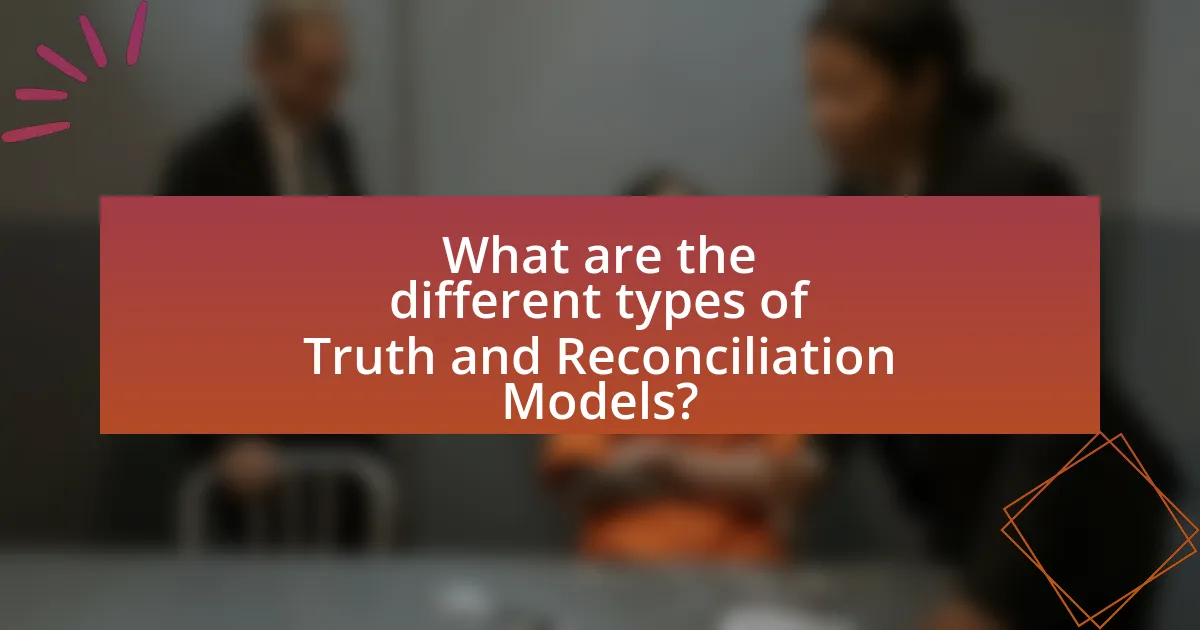
What are the different types of Truth and Reconciliation Models?
The different types of Truth and Reconciliation Models include restorative justice models, legalistic models, and hybrid models. Restorative justice models focus on healing and reconciliation through dialogue and acknowledgment of harm, exemplified by South Africa’s Truth and Reconciliation Commission, which aimed to foster national unity post-apartheid. Legalistic models emphasize accountability and legal proceedings, such as the International Criminal Tribunal for the former Yugoslavia, which sought to prosecute war crimes. Hybrid models combine elements of both restorative and legalistic approaches, like the Sierra Leone Truth and Reconciliation Commission, which aimed to address both individual accountability and societal healing. Each model serves distinct purposes and reflects the unique historical and cultural contexts of the societies in which they are implemented.
How do restorative justice models differ from punitive models?
Restorative justice models focus on repairing harm and fostering dialogue between victims and offenders, while punitive models emphasize punishment and retribution. In restorative justice, the process involves the participation of all stakeholders, aiming to restore relationships and promote healing, as evidenced by practices such as victim-offender mediation. In contrast, punitive models prioritize the infliction of penalties on offenders, often leading to incarceration without addressing the underlying issues or the needs of victims. Research indicates that restorative justice can reduce recidivism rates and improve victim satisfaction compared to traditional punitive approaches, highlighting its effectiveness in promoting community healing and accountability.
What are the strengths and weaknesses of each approach?
The strengths of truth and reconciliation models include fostering national healing, promoting accountability, and encouraging dialogue among conflicting parties. For example, South Africa’s Truth and Reconciliation Commission successfully addressed past injustices, allowing victims to share their stories, which contributed to societal healing and reconciliation. However, weaknesses of these models often involve insufficient legal enforcement, leading to a lack of accountability for perpetrators, as seen in some cases where amnesty was granted without adequate justice for victims. Additionally, these approaches can sometimes exacerbate divisions if not implemented with broad societal support, as evidenced by challenges faced in countries like Rwanda, where the reconciliation process has been criticized for not adequately addressing underlying ethnic tensions.
How do these models address victim and perpetrator needs?
Truth and reconciliation models address victim and perpetrator needs by facilitating dialogue, acknowledgment, and reparative measures. These models create platforms where victims can share their experiences and receive recognition for their suffering, which is crucial for healing. For perpetrators, these models often provide opportunities for accountability and rehabilitation, allowing them to confront their actions and contribute to restorative justice. For instance, the South African Truth and Reconciliation Commission emphasized the importance of public testimonies from victims, which helped validate their experiences, while also offering amnesty to perpetrators who fully disclosed their crimes, thus promoting a sense of closure and societal healing.
What are some notable examples of Truth and Reconciliation Models worldwide?
Notable examples of Truth and Reconciliation Models worldwide include South Africa’s Truth and Reconciliation Commission (TRC), Canada’s Truth and Reconciliation Commission, and the Chilean National Commission on Truth and Reconciliation. The TRC in South Africa, established in 1995, aimed to address the atrocities of apartheid by documenting human rights violations and promoting national healing. Canada’s TRC, initiated in 2008, focused on the historical injustices faced by Indigenous peoples, particularly in residential schools, and produced 94 Calls to Action to foster reconciliation. The Chilean National Commission, formed in 1990, investigated human rights abuses during the Pinochet regime, providing a historical record and recommendations for reparations. Each of these models has contributed significantly to their respective societies’ processes of healing and reconciliation.
How did South Africa’s model influence global practices?
South Africa’s model of truth and reconciliation significantly influenced global practices by providing a framework for addressing past human rights violations through restorative justice rather than punitive measures. This approach, exemplified by the Truth and Reconciliation Commission (TRC) established in 1995, emphasized the importance of truth-telling, acknowledgment of suffering, and fostering national unity. Countries such as Rwanda, Sierra Leone, and Canada have adopted similar models, drawing on South Africa’s emphasis on dialogue and healing to navigate their own histories of conflict and injustice. The TRC’s findings and methodologies have been referenced in various international contexts, demonstrating its impact on shaping policies aimed at reconciliation and social cohesion worldwide.
What lessons can be learned from the Canadian Truth and Reconciliation Commission?
The Canadian Truth and Reconciliation Commission (TRC) teaches several important lessons about addressing historical injustices and fostering healing. Firstly, the TRC emphasizes the necessity of acknowledging and documenting past wrongs, particularly the impact of residential schools on Indigenous communities, which is crucial for building trust and understanding. The TRC’s final report, released in 2015, highlighted the importance of listening to survivors’ stories, which serves as a powerful tool for validation and recognition of their experiences.
Secondly, the TRC underscores the significance of education in promoting awareness and understanding of Indigenous histories and cultures among non-Indigenous populations. The TRC’s Calls to Action include recommendations for integrating Indigenous history into school curricula, which aims to foster a more informed and respectful society.
Lastly, the TRC illustrates the need for ongoing commitment to reconciliation through policy changes and community engagement. The implementation of the TRC’s recommendations requires sustained efforts from government and society to address systemic inequalities and promote healing. These lessons highlight the importance of truth-telling, education, and commitment to change in the reconciliation process.
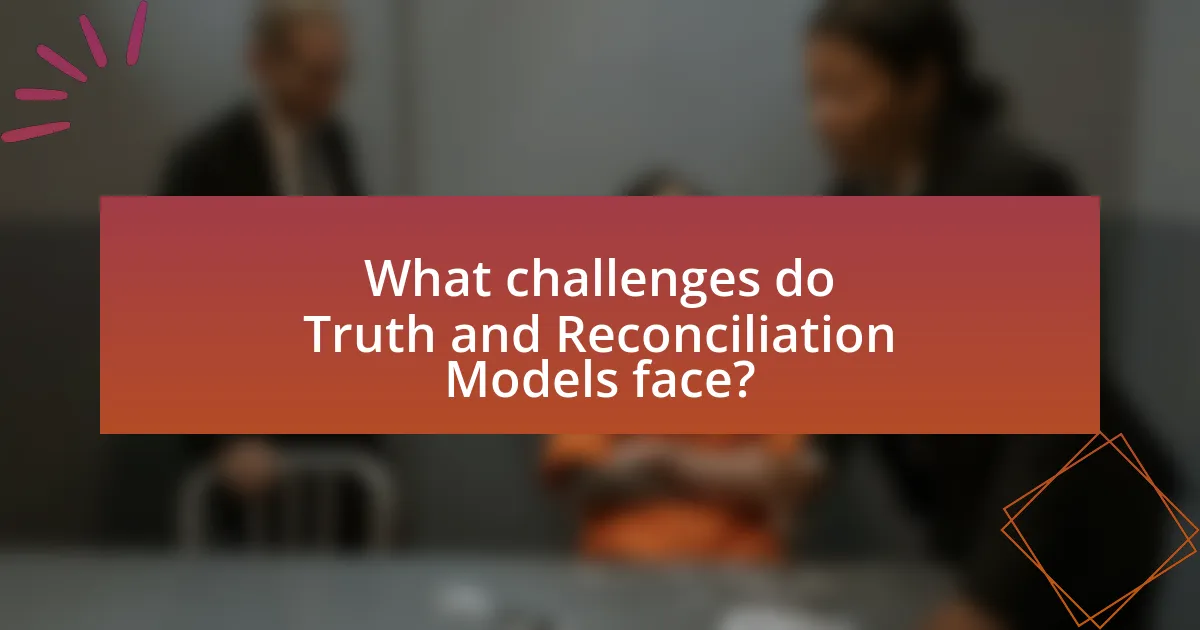
What challenges do Truth and Reconciliation Models face?
Truth and Reconciliation Models face significant challenges, including lack of political will, insufficient funding, and societal resistance. Political will is crucial for the implementation of these models, as seen in South Africa, where initial support waned over time, hindering progress. Insufficient funding often leads to inadequate resources for effective operations, as evidenced by the limited budgets of various commissions, which restrict their ability to conduct thorough investigations. Societal resistance can manifest in skepticism or denial about historical injustices, complicating the reconciliation process, as observed in countries like Rwanda, where divisions persist despite efforts to promote unity. These challenges collectively impede the effectiveness and sustainability of Truth and Reconciliation Models globally.
How do political dynamics affect the implementation of these models?
Political dynamics significantly influence the implementation of truth and reconciliation models by shaping the political will and public support necessary for their success. For instance, in post-apartheid South Africa, the political transition facilitated the establishment of the Truth and Reconciliation Commission, which was supported by the ruling African National Congress and aimed at fostering national unity. Conversely, in countries like Rwanda, political power struggles and ethnic tensions have complicated the implementation of reconciliation efforts, as seen in the aftermath of the 1994 genocide, where political factions often obstructed collaborative initiatives. These examples illustrate that the degree of political stability, the alignment of political interests, and the presence of inclusive governance directly impact the effectiveness and sustainability of reconciliation models.
What are the common obstacles in achieving reconciliation?
Common obstacles in achieving reconciliation include deep-seated mistrust, lack of political will, and insufficient resources. Mistrust often stems from historical grievances and trauma, making it difficult for parties to engage in meaningful dialogue. The absence of political will can hinder the implementation of reconciliation processes, as leaders may prioritize short-term gains over long-term peace. Additionally, inadequate resources, both financial and human, can limit the effectiveness of reconciliation initiatives, preventing them from reaching their full potential. These factors collectively impede progress toward sustainable reconciliation in various contexts.
How do societal attitudes impact the success of these models?
Societal attitudes significantly influence the success of truth and reconciliation models by shaping public support and participation. When communities exhibit positive attitudes towards reconciliation, such as a willingness to forgive and engage in dialogue, these models tend to achieve better outcomes, as evidenced by the South African Truth and Reconciliation Commission, which succeeded partly due to widespread societal support for healing and unity post-apartheid. Conversely, negative societal attitudes, such as distrust or resistance to acknowledging past injustices, can hinder the effectiveness of these models, as seen in countries like Rwanda, where divisions and skepticism about the process have complicated reconciliation efforts.
What are the criticisms of existing Truth and Reconciliation Models?
Existing Truth and Reconciliation Models face several criticisms, primarily regarding their effectiveness in achieving genuine reconciliation and justice. Critics argue that these models often prioritize political expediency over accountability, leading to a lack of meaningful consequences for perpetrators of human rights violations. For instance, in South Africa, the Truth and Reconciliation Commission has been criticized for granting amnesty to individuals without sufficient scrutiny, which some believe undermines the pursuit of justice for victims. Additionally, many models are seen as inadequate in addressing the socio-economic disparities that persist after conflicts, failing to provide reparations or support for affected communities. Research by the International Center for Transitional Justice highlights that without addressing underlying inequalities, reconciliation efforts may be superficial and fail to foster lasting peace.
How do critics argue these models fail to deliver justice?
Critics argue that truth and reconciliation models fail to deliver justice primarily due to their tendency to prioritize reconciliation over accountability. This approach often results in perpetrators of human rights violations escaping legal consequences, undermining the rule of law. For instance, in South Africa, the Truth and Reconciliation Commission allowed many offenders to avoid prosecution in exchange for testimony, which critics claim perpetuated a culture of impunity. Additionally, these models may marginalize victims’ voices, as the focus shifts to collective healing rather than individual justice, leading to feelings of betrayal among those seeking reparation. Studies indicate that without adequate legal frameworks and enforcement mechanisms, the promise of justice remains unfulfilled, leaving victims without the closure they deserve.
What alternative approaches have been proposed?
Alternative approaches to truth and reconciliation models include restorative justice, reparative justice, and community-based reconciliation initiatives. Restorative justice focuses on repairing harm through dialogue and mutual agreement between victims and offenders, emphasizing accountability and healing rather than punishment. Reparative justice seeks to address historical injustices through compensation and systemic change, aiming to rectify the socio-economic disparities caused by past wrongs. Community-based reconciliation initiatives prioritize local involvement and culturally relevant practices, fostering grassroots participation to build trust and understanding among conflicting groups. These approaches have been proposed to enhance the effectiveness of traditional truth and reconciliation processes by addressing underlying issues and promoting sustainable peace.
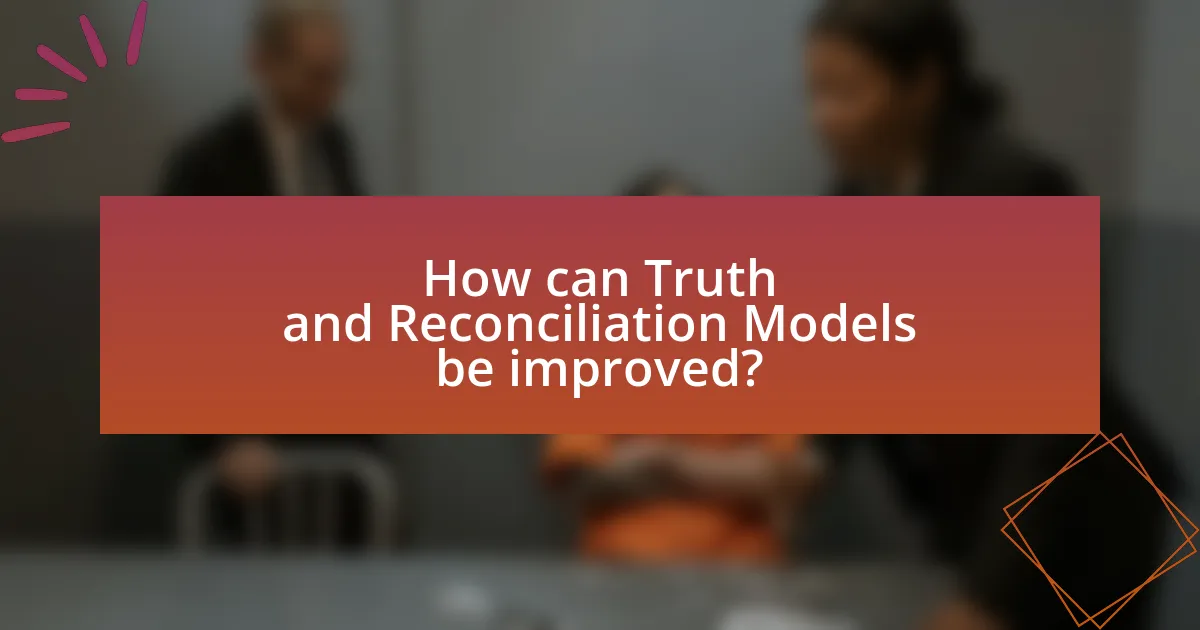
How can Truth and Reconciliation Models be improved?
Truth and Reconciliation Models can be improved by incorporating broader community engagement and ensuring diverse representation in the reconciliation process. Research indicates that models which actively involve marginalized groups and local communities yield more sustainable outcomes, as seen in the South African Truth and Reconciliation Commission, which emphasized inclusivity. Additionally, integrating restorative justice principles can enhance healing by focusing on victim needs and community restoration, as evidenced by the success of the Canadian Truth and Reconciliation Commission in addressing Indigenous issues. Implementing ongoing education and awareness programs can also foster a culture of understanding and prevent future conflicts, reinforcing the importance of historical context in reconciliation efforts.
What best practices can enhance the effectiveness of these models?
Best practices that can enhance the effectiveness of truth and reconciliation models include ensuring inclusive participation, establishing clear communication channels, and fostering a culture of accountability. Inclusive participation allows diverse community voices to contribute, which strengthens legitimacy and trust in the process. Clear communication channels facilitate transparency and keep stakeholders informed, thereby reducing misinformation and fostering engagement. Fostering a culture of accountability ensures that perpetrators are held responsible, which can deter future violations and promote healing. Research by the International Center for Transitional Justice indicates that these practices significantly improve the outcomes of reconciliation efforts, as they address the needs and concerns of affected communities while promoting social cohesion.
How can community involvement be increased in the reconciliation process?
Community involvement in the reconciliation process can be increased by implementing inclusive dialogue initiatives that actively engage diverse community members. These initiatives can include town hall meetings, workshops, and collaborative projects that encourage participation from various demographic groups, ensuring that all voices are heard. Research indicates that successful reconciliation efforts, such as those in South Africa and Canada, have utilized community-driven approaches to foster trust and understanding among conflicting parties. For instance, the Truth and Reconciliation Commission in Canada emphasized community engagement through public hearings and local events, which significantly enhanced participation and ownership of the reconciliation process.
What role does education play in fostering understanding and acceptance?
Education plays a crucial role in fostering understanding and acceptance by providing individuals with knowledge about diverse cultures, histories, and perspectives. This knowledge helps to break down stereotypes and prejudices, facilitating empathy and respect among different groups. For instance, educational programs that include multicultural curricula have been shown to improve intergroup relations and reduce discrimination, as evidenced by studies such as the one conducted by the American Psychological Association, which found that students exposed to diverse perspectives in their education reported higher levels of acceptance and understanding of others.
What practical steps can be taken to implement successful Truth and Reconciliation Models?
To implement successful Truth and Reconciliation Models, it is essential to establish a clear legal framework that supports the process. This framework should include provisions for truth commissions, reparations, and mechanisms for accountability. For instance, South Africa’s Truth and Reconciliation Commission (TRC) was grounded in legislation that defined its powers and scope, allowing it to effectively address past injustices.
Next, engaging diverse stakeholders, including victims, perpetrators, and civil society, is crucial for fostering inclusivity and legitimacy. The TRC in South Africa involved extensive public hearings, which allowed victims to share their stories and contributed to a collective understanding of the past.
Additionally, ensuring transparency and public access to findings promotes trust in the process. The publication of the TRC’s final report, which documented human rights violations, served as a vital resource for historical record and accountability.
Finally, integrating educational initiatives that promote awareness of the reconciliation process can help build a culture of peace and understanding. Countries like Canada have implemented educational programs that address the legacy of residential schools, fostering dialogue and healing among communities.
How can stakeholders collaborate for better outcomes?
Stakeholders can collaborate for better outcomes by establishing clear communication channels, setting shared goals, and engaging in joint decision-making processes. Effective collaboration requires stakeholders to actively listen to each other’s perspectives, which fosters trust and mutual understanding. For instance, in the context of truth and reconciliation models, successful initiatives often involve diverse groups, including government representatives, civil society, and affected communities, working together to address historical grievances. Research indicates that collaborative approaches can lead to more sustainable and inclusive solutions, as seen in the South African Truth and Reconciliation Commission, where stakeholder engagement was crucial in promoting national healing and unity.
What resources are available for communities seeking to establish these models?
Communities seeking to establish truth and reconciliation models can access various resources, including governmental guidelines, non-governmental organization (NGO) support, and academic research. For instance, the United Nations provides frameworks and best practices for reconciliation processes, which can be found in documents like the “United Nations Guidance on Transitional Justice.” Additionally, organizations such as the International Center for Transitional Justice offer toolkits and training programs tailored for communities. Academic institutions often publish case studies and analyses that can serve as valuable references, such as the research conducted by the Institute for Justice and Reconciliation, which focuses on lessons learned from past reconciliation efforts. These resources collectively equip communities with the necessary knowledge and support to effectively implement truth and reconciliation models.
